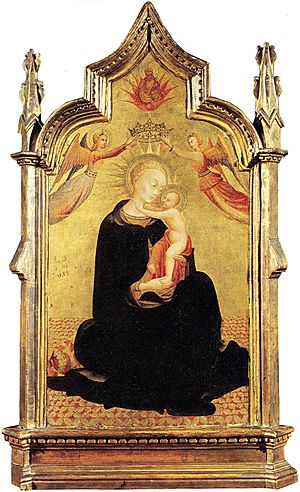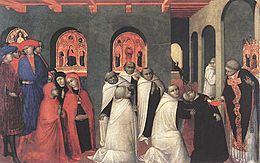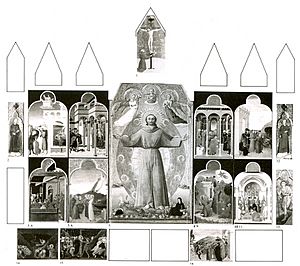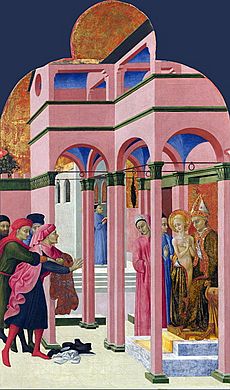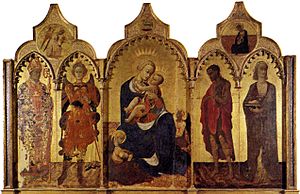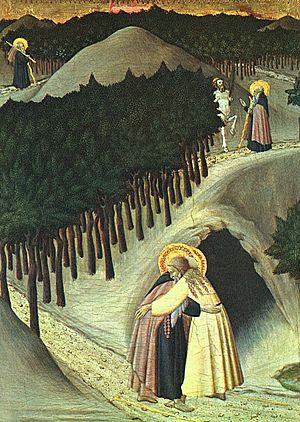Stefano di Giovanni facts for kids
Quick facts for kids
Sassetta
|
|
|---|---|
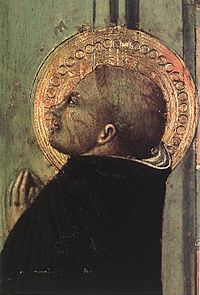
Detail of il Sassetta's Ispirazione di San Tommaso, 1423, Museum of Art, Budapest
|
|
| Born |
Stefano di Giovanni di Consolo
around 1392 Siena or Cortona
|
| Died | 1450 or 1451 (age 58 or 59) |
| Nationality | Sienese |
| Known for | Painting |
Stefano di Giovanni di Consolo, also known as il Sassetta, was an important Italian painter. He lived from about 1392 to 1450. Sassetta was a key artist in the Sienese School of painting during the Renaissance.
He worked in the traditional Sienese style. However, he also added new ideas to his art. These included decorative elements from the Gothic style. He also used the realistic touches seen in the works of Florentine painters like Masaccio.
Contents
Life of a Renaissance Painter
The name Sassetta was linked to him much later, in the 1700s. But now, everyone uses it for this artist. We don't know exactly when or where Sassetta was born. Some people think he was born in Siena. Others believe he was born in Cortona. His father, Giovanni, was called "da Cartona." This might mean Cortona was Sassetta's birthplace. The meaning of his nickname, Sassetta, is not clear. It wasn't used in documents from his own time.
Sassetta likely learned to paint from artists like Benedetto di Bindo and Gregorio di Cecco. But he developed his own unique style. He became very skilled at painting. He also knew about the new art ideas from talented painters in Florence. These included Gentile da Fabriano and Masolino. His work was different from the late Gothic style of many other Sienese artists of his time.
His first confirmed work was the Arte della Lana altarpiece. He painted it between 1423 and 1426. Parts of this altarpiece are now in different art collections.
The Madonna of the Snow altarpiece was a big project for Sassetta. He painted it for the Siena Cathedral. This is seen as his second major work. In this painting, he made his figures look very natural. He used light to shape them well. He also showed great skill in creating space in his paintings. From this time, Sassetta's style became more decorative. This was due to Gothic influences.
Sassetta also painted a polyptych (a painting with many panels) for San Domenico at Cortona. This was around 1437. It showed scenes from the life of Saint Anthony the Abbot. He was very good at telling stories through his art. He also used beautiful colors and balanced designs.
It is believed that Vecchietta, another famous painter, was Sassetta's student.
Sassetta died from pneumonia. He caught the illness while painting a fresco called Assumption. This fresco was on the Porta Romana in Siena. His student, Sano di Pietro, finished the work.
Many people think Sassetta's mix of old and new styles was very important. It helped Siena move from the Gothic to the Renaissance style of painting.
A Miracle of the Eucharist
Sassetta was a very religious man. One of his paintings, A Miracle of the Eucharist, tells a powerful story. It is about what happens when someone pretends to have faith. It also shows the power of God.
In the painting, a man in black is an unbeliever. He is receiving Communion, a religious ceremony. The priest offers him the host (a special wafer) on a plate. The host is shown miraculously bleeding. The unbeliever instantly dies. A tiny black devil flies above his face. It is there to take his soul to Hell. The other men in the painting are Carmelite monks. They look shocked, amazed, and disgusted. This painting is a very detailed scene. It remembers the Miracle of Bolsena. This miracle is said to have happened in 1263.
Sassetta's Altarpiece of the Eucharist was later split up. Parts of it are now in three different museums. These are in Britain, Hungary, and Italy. Other parts are in the Vatican and a private collection.
The Borgo San Sepolcro Altarpiece
This altarpiece was first painted in Siena. Then it was moved to Sansepolcro. It was placed in the church of San Francesco. In 1900, the Berenson family bought three panels by Sassetta. These panels showed St. Francis in Glory. On either side were Blessed Ranieri and St. John the Baptist.
Experts later found that these were only part of a much larger altarpiece. This big altarpiece was then spread across twelve collections. These collections were in Europe and North America. Art historians agree that Sassetta's San Francesco altarpiece was one of the biggest and most expensive of its time. The fact that a Sienese artist painted it in Siena shows how famous Sassetta was. It was then shipped to the town in the Tiber valley in 1444.
Bernard Berenson gave many of Sassetta's paintings from his home in Florence to Harvard University. These paintings are now part of the Center for Italian Renaissance Studies in Florence.
Selected works
- Meeting of Saint Antonio and Saint Paul (around 1440), tempera on wood, National Gallery of Art, Washington D.C., USA
- Vision of Saint Thomas of Aquino before the Cross, (1423), Pinacoteca Vaticana
- Saint Thomas inspired by the dove of the Holy Spirit, tempera on wood, Museum of Fine Arts, Budapest
- Madonna of the Snows Altarpiece (around 1430–1432), Galleria degli Uffizi, Florence
- A predella (lower part of an altarpiece) of three works at the Detroit Institute of Arts
- San Domenico da Cortona Polyptych (around 1434), Diocesan Museum, Cortona, Italy
- The Journey of the Magi (1435) Metropolitan Museum of Art, New York, USA
- Saint Anthony the Hermit Tortured by Devils, Pinacoteca Nazionale, Siena
- Virgin and Child Adored by Six Angels (1437–44), Louvre Museum, Paris, France
- The Burning of a Heretic (1423), National Gallery of Victoria, Melbourne, Australia
- Last Supper (1423), Pinacoteca Nazionale, Siena
- Ecstasy of Saint Francis (1437–44), Villa I Tatti, Settignano, Italy
- The Miracle of the Eucharist, Bowes Museum, Barnard Castle, United Kingdom
- Saint Francis receiving stigmata (1437–44), National Gallery, London, United Kingdom
- Mystic Marriage of St. Francis (around 1450), Musée Condé, Chantilly, France
See also
 In Spanish: Sassetta para niños
In Spanish: Sassetta para niños


